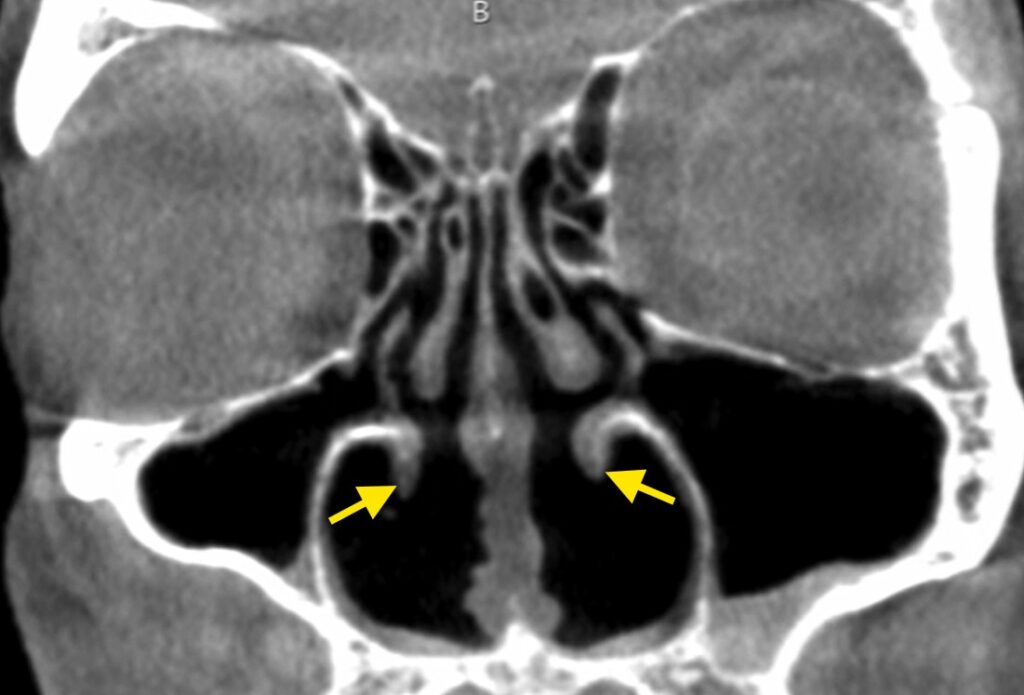
Empty Nose Syndrome (ENS) is a relatively rare but debilitating condition that affects the nasal passages. Despite its name, the condition doesn’t mean the nose is literally empty, but rather that it feels empty due to the changes in nasal airflow and sensations. Having studied ENS extensively, here we share valuable insights into its pathophysiology, symptoms, and treatments.
Dr. Rogers evaluates a handful of new patients every month with either full blown ENS or other forms of functional nasal obstruction along with some component of ENS or functional nasal dyspnea. Rogers’ practice focusses on adult patients with nasal and sinus complaints.
What Causes Empty Nose Syndrome?
To understand ENS, it’s essential first to understand the nasal turbinates. These are small structures inside the nose that help regulate airflow, humidify the air we breathe, and filter out dust and allergens. In some cases, particularly after nasal surgery, parts of the turbinates may be removed or damaged. This can lead to a disruption in normal nasal airflow, creating a sensation that the nose is blocked or, paradoxically, too open—hence the term “empty.”
The pathophysiology of ENS involves a combination of structural changes in the nasal anatomy and sensory nerve damage. When turbinates are removed or altered, the remaining tissue may struggle to maintain the proper humidity and temperature of inhaled air. This results in a dry, uncomfortable nose—a condition known as rhinitis sicca. Rhinitis sicca can exacerbate ENS symptoms, making the nasal passages feel dry, crusty, and irritated.
There is also usually a significant psychologic component to ENS. Most people who notice ENS meet criteria for a defined psychological disorder even before surgery or the inciting event even happened. This is important, because working to treat the underlying mood disorder is often a needed part of the solution.
Recognizing the Symptoms
ENS can be challenging to diagnose because its symptoms overlap with other nasal conditions. Common symptoms include:
- A feeling of nasal congestion despite a clear nasal passage
- A sensation of having too much air flow through the nose
- Nasal dryness and crusting
- Frequent nosebleeds
- Difficulty breathing, especially at night
- A sense of suffocation, especially when lying down
- Anxiety and depression, often due to the chronic nature of the condition
Patients with ENS often describe a sensation that their nose is not functioning correctly. This can lead to a significant decrease in quality of life, as the nose plays a crucial role in breathing, filtering air, and providing sensory feedback.
Treatment Options: From Topical Agents to Advanced Procedures
Treating ENS can be complex, so I emphasizes the importance of a tailored approach. Since ENS often involves severe dryness and irritation, the first line of treatment usually involves topical hydrating agents. These agents, such as saline sprays, gels, and ointments, help to moisturize the nasal passages, reducing dryness and discomfort. In some cases, humidifiers and nasal irrigation with saline solutions can also provide relief by maintaining moisture in the nasal tissues.
However, for many patients, topical treatments alone are not enough. This is where more advanced treatments, like platelet-rich plasma (PRP), come into play. PRP is a cutting-edge therapy that involves using the patient’s blood to promote healing and regeneration of damaged tissues. The blood is processed to concentrate the platelets, which are then injected or applied to the affected areas during a minor office procedure.
Dr. Rogers explains that PRP may be particularly beneficial in ENS because it helps to restore the health and function of the remaining nasal tissues. By promoting tissue regeneration, PRP can help to improve the moisture-retaining abilities of the nasal lining, reduce inflammation, and potentially restore some of the lost sensory functions. The procedure is typically done under local anesthesia, and patients can return home the same day.
Moving Forward: Hope for ENS Patients
While ENS is a challenging condition, ongoing research and advances in treatment options offer hope for those affected. Dr. Rogers and other ENT specialists are continually exploring new ways to manage and treat ENS, with the goal of improving patients’ quality of life.
If you suspect you may have ENS or are struggling with chronic nasal symptoms, it’s essential to consult with an ENT specialist who is familiar with the condition. Early diagnosis and intervention can make a significant difference in managing symptoms and preventing further complications.
In conclusion, while ENS can be a life-altering condition, understanding its underlying mechanisms and exploring various treatment options can provide a path to relief. With the expertise of the right specialists patients with ENS have access to treatments that can help them regain comfort and function in their daily lives.

